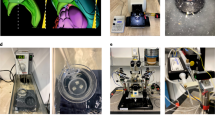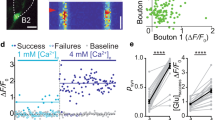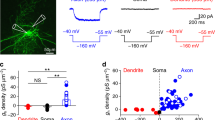Abstract
Understanding the physiology of axons in the central nervous system requires experimental access to intact axons. This protocol describes how to perform cell-attached recordings from narrow axon fibers (ϕ <1 μm) in acute and cultured brain slice preparations (with a success rate of ∼50%). By using fluorophore-coated glass pipettes and Nipkow disk confocal microscopy, fluorescently labeled axons can be visually targeted under online optical control. In the cell-attached configuration, axonal action potentials are extracellularly recorded as unit-like, sharp negative currents. The axon morphology labeling and cell-attached recordings of axons can be completed within 1–2 h. The recordings are stable for at least 30 min.
This is a preview of subscription content, access via your institution
Access options
Subscribe to this journal
Receive 12 print issues and online access
$259.00 per year
only $21.58 per issue
Buy this article
- Purchase on Springer Link
- Instant access to full article PDF
Prices may be subject to local taxes which are calculated during checkout




Similar content being viewed by others
References
Debanne, D. Information processing in the axon. Nat. Rev. Neurosci. 5, 304–316 (2004).
Astman, N., Gutnick, M.J. & Fleidervish, I.A. Persistent sodium current in layer 5 neocortical neurons is primarily generated in the proximal axon. J. Neurosci. 26, 3465–3473 (2006).
de Polavieja, G.G., Harsch, A., Kleppe, I., Robinson, H.P. & Juusola, M. Stimulus history reliably shapes action potential waveforms of cortical neurons. J. Neurosci. 25, 5657–5665 (2005).
Shu, Y., Hasenstaub, A., Duque, A., Yu, Y. & McCormick, D.A. Modulation of intracortical synaptic potentials by presynaptic somatic membrane potential. Nature 441, 761–765 (2006).
Kole, M.H., Letzkus, J.J. & Stuart, G.J. Axon initial segment Kv1 channels control axonal action potential waveform and synaptic efficacy. Neuron 55, 633–647 (2007).
Shu, Y., Yu, Y., Yang, J. & McCormick, D.A. Selective control of cortical axonal spikes by a slowly inactivating K+ current. Proc. Natl. Acad. Sci. USA 104, 11453–11458 (2007).
Alle, H. & Geiger, J.R. Combined analog and action potential coding in hippocampal mossy fibers. Science 311, 1290–1293 (2006).
Scott, R., Ruiz, A., Henneberger, C., Kullmann, D.M. & Rusakov, D.A. Analog modulation of mossy fiber transmission is uncoupled from changes in presynaptic Ca2+. J. Neurosci. 28, 7765–7773 (2008).
Christie, J.M., Chiu, D.N. & Jahr, C.E. Ca2+-dependent enhancement of release by subthreshold somatic depolarization. Nat. Neurosci. 14, 62–68 (2011).
Sasaki, T., Matsuki, N. & Ikegaya, Y. Effects of axonal topology on the somatic modulation of synaptic outputs. J. Neurosci. 32, 2868–2876 (2012).
Sasaki, T., Matsuki, N. & Ikegaya, Y. Action-potential modulation during axonal conduction. Science 331, 599–601 (2011).
Awatramani, G.B., Price, G.D. & Trussell, L.O. Modulation of transmitter release by presynaptic resting potential and background calcium levels. Neuron 48, 109–121 (2005).
Hori, T. & Takahashi, T. Mechanisms underlying short-term modulation of transmitter release by presynaptic depolarization. J. Physiol. 587, 2987–3000 (2009).
Alle, H. & Geiger, J.R. Analog signalling in mammalian cortical axons. Curr. Opin. Neurobiol. 18, 314–320 (2008).
Geiger, J.R. & Jonas, P. Dynamic control of presynaptic Ca2+ inflow by fast-inactivating K+ channels in hippocampal mossy fiber boutons. Neuron 28, 927–939 (2000).
Bischofberger, J., Engel, D., Li, L., Geiger, J.R. & Jonas, P. Patch-clamp recording from mossy fiber terminals in hippocampal slices. Nat. Protoc. 1, 2075–2081 (2006).
Forsythe, I.D. Direct patch recording from identified presynaptic terminals mediating glutamatergic EPSCs in the rat CNS, in vitro. J. Physiol. 479 (Part 3), 381–387 (1994).
Palmer, L.M. et al. Initiation of simple and complex spikes in cerebellar Purkinje cells. J. Physiol. 588, 1709–1717 (2010).
Rudolph, S., Overstreet-Wadiche, L. & Wadiche, J.I. Desynchronization of multivesicular release enhances Purkinje cell output. Neuron 70, 991–1004 (2011).
Atherton, J.F., Wokosin, D.L., Ramanathan, S. & Bevan, M.D. Autonomous initiation and propagation of action potentials in neurons of the subthalamic nucleus. J. Physiol. 586, 5679–5700 (2008).
Monsivais, P., Clark, B.A., Roth, A. & Hausser, M. Determinants of action potential propagation in cerebellar Purkinje cell axons. J. Neurosci. 25, 464–472 (2005).
Ishikawa, D. et al. Fluorescent pipettes for optically targeted patch-clamp recordings. Neural Netw. 23, 669–672 (2010).
Sasaki, T., Takahashi, N., Matsuki, N. & Ikegaya, Y. Fast and accurate detection of action potentials from somatic calcium fluctuations. J. Neurophysiol. 100, 1668–1676 (2008).
Takahashi, N., Sasaki, T., Matsumoto, W., Matsuki, N. & Ikegaya, Y. Circuit topology for synchronizing neurons in spontaneously active networks. Proc. Natl. Acad. Sci. USA 107, 10244–10249 (2010).
Koyama, R. et al. A low-cost method for brain slice cultures. J. Pharmacol. Sci. 104, 191–194 (2007).
De Simoni, A. & Yu, L.M. Preparation of organotypic hippocampal slice cultures: interface method. Nat. Protoc. 1, 1439–1445 (2006).
Debanne, D. et al. Paired-recordings from synaptically coupled cortical and hippocampal neurons in acute and cultured brain slices. Nat. Protoc. 3, 1559–1568 (2008).
Takahashi, N. et al. High-speed multineuron calcium imaging using Nipkow-type confocal microscopy. Curr. Protoc. Neurosci. 57, 2.14.1–2.14.10 (2011).
Perkins, K.L. Cell-attached voltage-clamp and current-clamp recording and stimulation techniques in brain slices. J. Neurosci. Methods 154, 1–18 (2006).
Takahashi, N. et al. Locally synchronized synaptic inputs. Science 335, 353–356 (2012).
Acknowledgements
This work was supported in part by the Funding Program for Next Generation World-Leading Researchers (LS023).
Author information
Authors and Affiliations
Contributions
T.S. collected experimental data and carried out the data analysis. T.S. and Y.I. wrote the manuscript. N.M. supervised the project and provided feedback on the manuscript.
Corresponding author
Ethics declarations
Competing interests
The authors declare no competing financial interests.
Supplementary information
Supplementary Video 1
Targeted axon-attached recording from an axon of a hippocampal pyramidal cell. (AVI 8228 kb)
Rights and permissions
About this article
Cite this article
Sasaki, T., Matsuki, N. & Ikegaya, Y. Targeted axon-attached recording with fluorescent patch-clamp pipettes in brain slices. Nat Protoc 7, 1228–1234 (2012). https://doi.org/10.1038/nprot.2012.061
Published:
Issue Date:
DOI: https://doi.org/10.1038/nprot.2012.061
This article is cited by
-
Electrical coupling between hippocampal neurons: contrasting roles of principal cell gap junctions and interneuron gap junctions
Cell and Tissue Research (2018)
-
Action potential broadening in a presynaptic channelopathy
Nature Communications (2016)
-
Excitability tuning of axons in the central nervous system
The Journal of Physiological Sciences (2016)
-
Quantum dot–based multiphoton fluorescent pipettes for targeted neuronal electrophysiology
Nature Methods (2014)
Comments
By submitting a comment you agree to abide by our Terms and Community Guidelines. If you find something abusive or that does not comply with our terms or guidelines please flag it as inappropriate.



